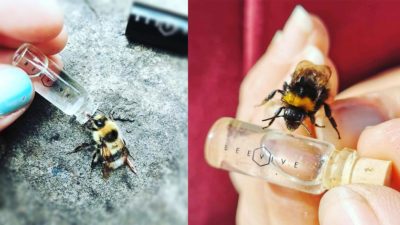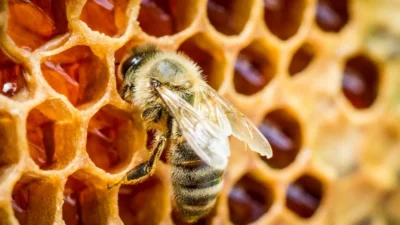How Honey Bees are Farmed and Killed
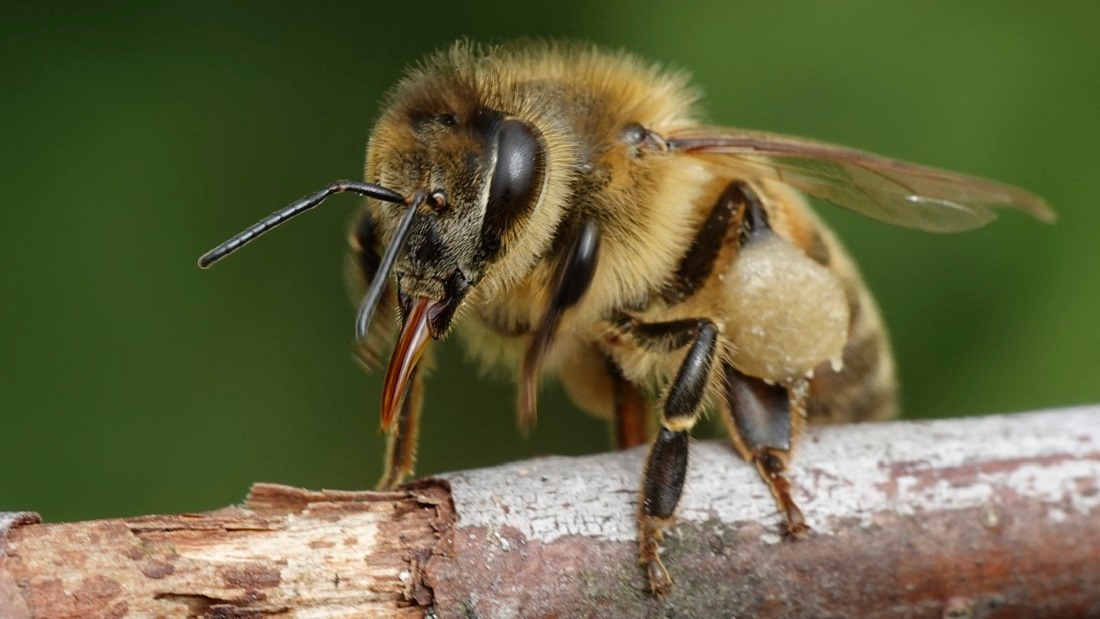
- When the queen bee dies, ‘worker’ bees create a new queen by selecting a freshly hatched little grub and feeding them ‘royal jelly’. They secrete it from their glands and this nutritional superfood transforms a run-of-the-mill ‘larva’ into a magnificent queen.1Natgeokids.com. 2020. Honeybees. Available at: https://www.natgeokids.com/uk/discover/animals/insects/honey-bees/ [Accessed 5th June 2020]
- Bees really are busy. A single worker bee may visit up to 10,000 flowers in a single day and a single colony, added together, can fly to the Moon every day in terms of distance covered.2Bbka.org.uk. 2020. Bee facts. Available at: https://www.bbka.org.uk/pages/faqs/category/bee-facts [Accessed 16th June]
- Bees dance for their dinner. To share information about the location of the best food sources, or a new hive, a bee will perform ‘the waggle dance’ – moving their body in figures-of-eight to indicate where the food is.1Natgeokids.com. 2020. Honeybees. Available at: https://www.natgeokids.com/uk/discover/animals/insects/honey-bees/ [Accessed 5th June 2020]
- The queen bee controls the motivations and actions of her entire hive through a pheromone she releases from her glands known as ‘the queen signal’.3Bortolotti L, Costa C. 2014. Chemical Communication in the Honey Bee Society. Neurobiology of Chemical Communication. Available from: https://www.ncbi.nlm.nih.gov/books/NBK200983/
- One-third of the food we eat depends on pollinators such as honey bees. They help to transfer pollen between the male and female parts of plants, fertilising them so they can grow seeds and fruit.4Quinn, S. 2020. How beekeepers are keeping food production going despite the sting of lockdown. Available at: https://www.independent.co.uk/life-style/food-and-drink/bees-pollen-food-production-farming-beekeepers-lockdown-a9489061.html#gsc.tab=0
- Bees are able to navigate using the sun, even when it is behind a thick cloud. Being sensitive to polarised light, they are able to find their way home even on the greyest of days.2Bbka.org.uk. 2020. Bee facts. Available at: https://www.bbka.org.uk/pages/faqs/category/bee-facts [Accessed 16th June]
- Honey bees are incredible flyers and hit speeds of around 25km per hour – about the same as an average cyclist. To maintain this speed, they have to beat their wings 200 times per second.1Natgeokids.com. 2020. Honeybees. Available at: https://www.natgeokids.com/uk/discover/animals/insects/honey-bees/ [Accessed 5th June 2020]
- Bees have an exceptional sense of smell. Each bee has 170 odorant receptors which they use to recognise different flowers and communicate with other bees.1Natgeokids.com. 2020. Honeybees. Available at: https://www.natgeokids.com/uk/discover/animals/insects/honey-bees/ [Accessed 5th June 2020]
- In her entire lifetime, one bee will produce just one-twelfth of a teaspoonful of honey.5BBC.co.uk. 2020. The buzz about bees. Available at: https://www.bbc.co.uk/programmes/articles/3Q6DBVG8czjnrkYP0sKl2NZ/the-buzz-about-bees
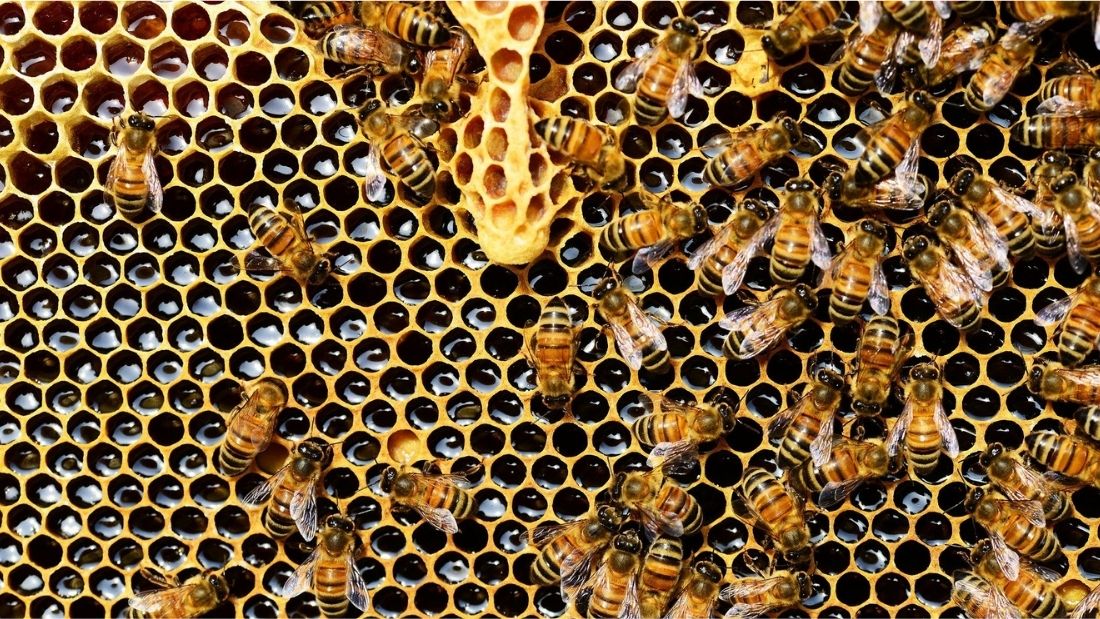
Bees win the animal kingdom’s gold medal for organisation. Most species work to ensure the survival of the fittest but not bees, they are ‘eusocial’, which means they act to ensure the survival of their whole colony. They have an incredibly complex, highly cooperative system at the heart of which sits the queen bee.
A colony typically consists of tens of thousands of individuals, each with their own role to play in keeping the community healthy and thriving.
Individual roles
Each hive usually has one queen, hundreds of drones, and thousands of workers.1Bbka.org.uk. 2020. What’s in the hive? Available at: https://www.bbka.org.uk/whats-in-the-hive [Accessed 16 June 2020]
The queen rules the whole hive and her job is to lay eggs that will spawn the next generation colony – a kind of mass reproduction. To do it, she can lay thousands of eggs a day during the spring and summer – more than her own bodyweight in eggs every day.2Moore et al, 2015. Honey Bee Queens: Evaluating the Most Important Colony Member. Available at: https://bee-health.extension.org/honey-bee-queens-evaluating-the-most-important-colony-member/ The queen will be fertilised by one of the drones via a ‘mating flight’, for a newly emerged queen it may take two to three weeks for her to start laying eggs.
‘Worker’ bees are all female and their job is to build, maintain and protect the hive, as well as making sure that the queen and her brood are well fed. To do this, they travel many miles a day foraging for nectar and pollen from flowers.
Some workers are also scouts and roam far and wide to find a location for their next hive. This happens when the colony has to split due to overpopulation. New, virgin queens are selected and fed the magic royal jelly. The first one to hatch will be the new queen. .
When she is about to hatch, half the hive and the old queen will leave the hive and relocate to a new one that the scouting bees have found.3Kauffeld,N. 1980. Seasonal Cycle of Activities in Honey Bee Colonies,, Agricultural Handbook Number 335. 30-2.
Bees will alert other members of their hive as to new potential locations through intricate dance movements known as ‘the waggle dance’.6Anderson, C & Ratnieks, F. 1999. Worker Allocation in Insect Societies: Coordination of Nectar Foragers and Nectar Receivers in Honey Bee (Apis mellifera) Colonies. Behavioral Ecology and Sociobiology 73-81.
Male bees are called drones and their sole job is to mate with the queen bee during spring and summer. When winter comes and the hive goes into survival mode, drones are all kicked out and left to die.
The queen signal
Honey bees communicate through chemical substances known as pheromones which are released via their exocrine glands. Together with the honey bee dance, honey bee pheromones represent one of the most advanced ways of communication among social insects. These pheromones are the glue that holds the hive together – they control the behaviour and motivations of other bees in the colony including mating, foraging and defence of the hive.
There are various different types of these pheromones, or chemical blends, which are released by different members of the hive in different situations. They allow communication between bees within the same hive and provoke necessary behaviours so that the queen can control her workers and the workers can communicate with drones.5Trhlin M, Rajchard J. 2011. Chemical communication in the honey bee (Apis mellifera L.): A review. Vet Med-Czech. 265–73.
For example, the alarm pheromone, which alerts other bees to danger, is released when a bee bites or stings an intruder, whereas the foraging pheromone is released via trophallaxis (food transfer mouth to mouth), and lets the other worker bees know when more foraging needs to be done.
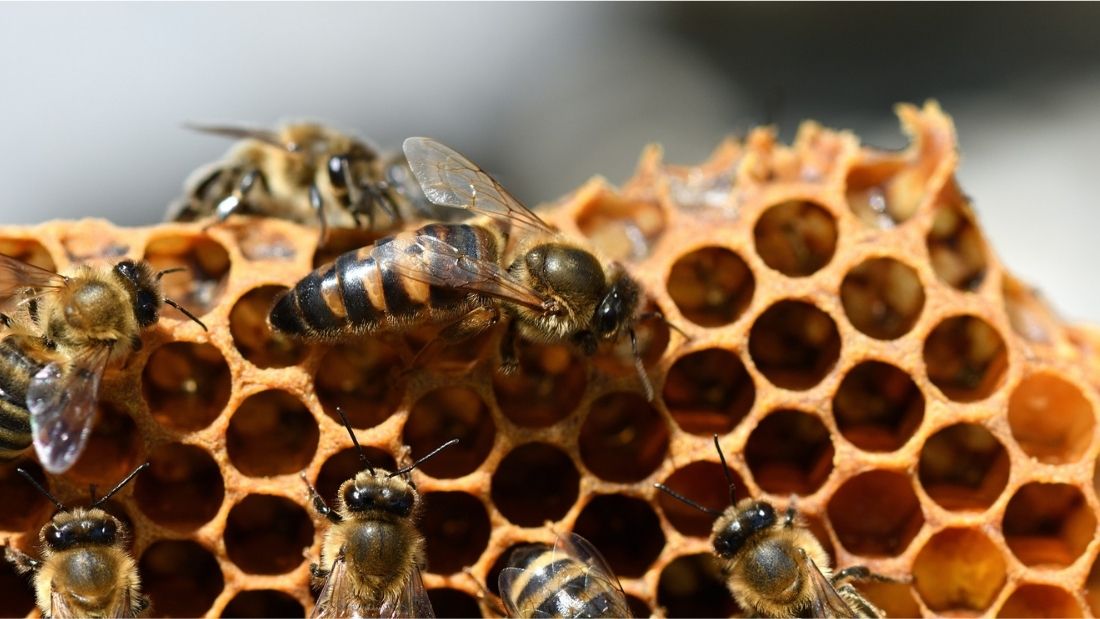
This primer pheromone which controls the motivations and functions of the whole hive is known as ‘the queen signal’. This complex chemical blend of pheromones, released by the queen, manipulates the behaviour of all the other bees in the hive ensuring that they all cooperate to preserve the hive in order to protect the queen and her brood by doing things such as cleaning, building, guarding, foraging and brood feeding. These chemicals also inhibit worker bees from reproducing, ensuring that reproduction remains the queen’s prerogative
When the queen’s pheromone releases start to dwindle, because she is ill or dying, it is this that triggers the workers to rear a new queen – and within 24 hours.
If for any reason this doesn’t happen, chaos quickly follows – without pheromones to guide them, worker bees stop performing their duties and the colony becomes disorganised, dirty and susceptible to disease and predators. The result is usually the collapse of the colony and certain death.6Bortolotti L, Costa C. 2014. Chemical Communication in the Honey Bee Society. Neurobiology of Chemical Communication. Available from: https://www.ncbi.nlm.nih.gov/books/NBK200983/
Collective survival
The hive works as a collective to ensure that each member has an adequate supply of honey and enough is stockpiled for winter. Despite visiting hundreds of flowers a day, each bee will produce only around one-twelfth of a teaspoon of honey in their lifetime.7BBC.co.uk. 2020. The buzz about bees. Available at: https://www.bbc.co.uk/programmes/articles/3Q6DBVG8czjnrkYP0sKl2NZ/the-buzz-about-bees [Accessed 15 July 2020]
When winter sets in and the temperature drops, the focus of the hive becomes survival and bees cluster around the queen and the young, using their body heat to keep the temperature inside the hive at a steady 35°C (95°F), just below the average human body temperature.8Allison,p. 2018. Can A Beehive Get Too Hot or Too Cold? Available at: https://www.allisonsapiaries.com/ideal-beehive-temperature-bees-honey/#:~:text=Beehives%20need%20to%20be%20kept,hive%20and%20fan%20their%20wings.
Male drones are kicked out to ensure survival of the rest of the hive.
The honey bee is one of 20,000 species of bee worldwide and the only species used to produce food that humans eat.1Clark , R. 2018. Guide to solitary bees in Britain. Available at: https://www.wildlifetrusts.org/blog/ryan-clark/guide-solitary-bees-britain#:~:text=What%20are%20solitary%20bees%3F,20%2C000%20described%20bee%20species%20worldwide. [Accessed 16th June 2020] There are seven subspecies of honey bee and the one native to the UK is the European honeybee (Apis mellifera).2Sen Nag, O. 2018. The Seven Different Types of Honey Bees. Available at: https://www.worldatlas.com/articles/the-seven-species-of-honey-bees-living-today.html [Accessed 16th June 2020]
The lifecycle of a honey bee
Honey bee eggs must be fertilised in order to produce female bees, so because the queen bee is the only bee in the hive that mates with other bees, she is the only bee that produces female young. While other females (workers) will lay eggs, these unfertilised eggs produce male bees (drones). The colony, therefore, relies on the queen bee’s fertility to produce the next generation.
The queen bee will lay up to 2,500 eggs a day in the summer months.3Natgeokids.com. 2020. Honeybees. Available at: https://www.natgeokids.com/uk/discover/animals/insects/honey-bees/ [Accessed 5th June 2020]
Each egg is laid inside the individual hexagonal wax cells that we would recognise as honeycomb. The honey bee larvae hatch about three or four days after being laid. The larvae will be fed by the workers until they emerge from their cells after around 16 days if they’re a queen, 21 days if they’re a worker and 24 days if they’re a drone.4Blackiston, H. 2020. Tracking the Life Cycle of a Honey Bee. Available at: https://www.dummies.com/home-garden/hobby-farming/beekeeping/tracking-the-life-cycle-of-a-honey-bee/
If selected as a ‘virgin queen’, those larvae will be given a special, larger cell and fed ‘royal jelly’, a nutrient-dense secretion produced by worker bees, to allow them to develop more quickly into larger bees, whilst also making them fertile. There can only be one new queen, so the first emerging queen will kill the others to ensure her supremacy.5Bortolotti L, Costa C. 2014. Chemical Communication in the Honey Bee Society. Neurobiology of Chemical Communication. Available from: https://www.ncbi.nlm.nih.gov/books/NBK200983/
A new queen will be selected if the old queen dies or is dying. Sometimes, when the hive becomes too large for one queen to rule, a second queen will be selected and it will split in two.
How long do honey bees live?
The queen bee usually lives between two and five years.6Gillespie, C. 2018. What is the lifespan of a honey bee? Available at: https://sciencing.com/life-span-honey-bee-6573678.html
In stark contrast, female worker bees literally work themselves to death and will only live an average of five to six weeks, or after roughly 500 miles of flight.7Bee-health.extension.org. 2019. How long do worker honey bees live? Available at: https://bee-health.extension.org/how-long-do-worker-honey-bees-live/ If they are born before the winter a worker may be lucky enough to live five to six months in the colony.
Drones will live for roughly eight weeks over the summer months before they are kicked out of the colony to die when the weather begins to get colder.6Gillespie, C. 2018. What is the lifespan of a honey bee? Available at: https://sciencing.com/life-span-honey-bee-6573678.html
A queen bee who lives until she is five may reign over 40 generations of bees before she dies.
Natural habitat
Bees are very picky about where they put their hive. They even have a team of scouts that go out to pick the perfect location. They will generally pick a site that is dry, protected from the weather and facing south or south-east to absorb maximum heat from the sun.
Honey bees construct their hives from wax which comes from glands on the bees’ bellies. The sugar content of the honey they make in their ‘honey stomach’ will be broken down in the glands to produce tiny flakes of wax. The bees will then chew the wax they produce until it becomes soft and moldable. They use the wax to build the hexagonal cells which hold the eggs, larvae and store the pollen and honey that worker bees bring into the hive.
This hexagonal construction has been a fascination for scientists since the study of bees began, but it is thought that the shape is the most practical to bear the weight of the vast amounts of honey that bees have to store, especially over the winter.8Askdruniverse.wsu.edu. 2020. Why do bees make hexagons in their hives? Why not any other shape? Available at: https://askdruniverse.wsu.edu/2015/11/02/why-do-bees-make-hexagons/#:~:text=The%20wax%20comes%20from%20glands,pounds%20of%20honey%2C%20Cobey%20said.
Why do bees need honey?
Honey is bees’ main source of energy and nutrients; without it they would starve. As it is too cold for bees to collect nectar from flowers during the winter months in Northern Europe, they must stockpile enough honey to last them five to six months.
How do bees make honey?
Bees will visit hundreds, and often thousands of flowers, to collect enough nectar to fill their ‘honey stomach’. This nectar is then broken down by enzymes from glands in their mouths, regurgitated and stored in the cells in their hives. Here it will be capped over with a thin layer of wax and stored until the bees need it.

Stored in this way, honey can be kept indefinitely – perfectly preserved honeycomb was found in the tombs of Pharaohs and is thought to be over 3,000 years old.9Nationalgeographic.com.au. 2015. Honey in the pyramids. Available at: https://www.nationalgeographic.com.au/history/honey-in-the-pyramids.aspx [Accessed 16th June 2020]
Beekeeping has been established for thousands of years. Domestication of bees is shown in Egyptian art from 4,500 years ago.1Crane, Eva. 1999. The world history of beekeeping and honey hunting. London: Duckworth. https://www.fwi.co.uk/arable/britains-bee-farmers-can-help-raise-crop-yields However, the industrialisation of beekeeping now means that beekeeping for commercial honey production is big business.
The Honey industry
The UK honey industry was worth around £24 million in 2018,2Wunsch, NG. 2019. Value of natural honey exported to the United Kingdom (UK) from 2001 to 2018. Available at: https://www.statista.com/statistics/512754/natural-honey-export-value-united-kingdom-uk/#:~:text=This%20statistic%20presents%20the%20value,compared%20to%20the%20previous%20year. while the global market was valued at $8.4 billion.3Grandreviewresearch.com. 2019. Honey Market Size, Share & Trends Analysis Report By Application (Food & Beverages, Personal Care & Cosmetics, Pharmaceutical), By Distribution Channel, By Region, And Segment Forecasts, 2019 – 2025. Available at: https://www.grandviewresearch.com/industry-analysis/honey-market
In the UK, there are around 400 professional bee farmers. Some manage as many as 3,000 hives, with each one containing up to 80,000 bees.4Allison, A. 2018. How Britain’s bee farmers can help raise crop yields. Available at: https://www.fwi.co.uk/arable/britains-bee-farmers-can-help-raise-crop-yields
Bred for productivity
Like all animal farming, the main aim of honey bee farming is high yield and profit. In conventional beekeeping, honey bees are specifically bred for productivity.
Although this selective breeding ensures higher yields for honey farmers, it is also problematic as it narrows the population gene pool. Importing different species of bees for use in hives increases their susceptibility to disease and large-scale die-offs.
Selective breeding often requires queen bees to be artificially inseminated, since relying on mating flights is unreliable. To extract the semen from the drones, they are caught and either crushed or squeezed hard until their semen is released. The drones are killed in this process.5Cbc.ca. 2016. Bee squeezer scientist collects drone sperm. Lots of it. Available at: https://www.cbc.ca/radio/asithappens/as-it-happens-wednesday-edition-1.3885424/bee-squeezer-scientist-collects-drone-sperm-lots-of-it-1.3885429
The queen bee will then be caught, restrained and have the drone semen injected into her. Beekeepers can buy queen bees online with their wings already clipped and be sent to them in the post.
An average hive produces around 11kg of honey in one season, whilst a super-productive hive could produce 27kg or more. To put that into perspective, bees would need to fly 55,000 miles, or two times around the world, just to produce 0.5kg of honey.6Bbka.org.uk. 2020. What’s in the hive? Available at: https://www.bbka.org.uk/whats-in-the-hive [Accessed 16 June]
Housing
In backyard beekeeping, traditionally bees are kept in a white, tiered wooden hives with a pitched roof. This design has been used since the mid-1850s and was created so that beekeepers could easily move their hives from place to place.
In commercial large-scale bee farming, hives are a similar size, and shape, but instead have flat roofs and removable drawers, like those in a chest of drawers, so that farmers can easily remove the honey. In the height of summer there are 35 to 40,000 bees in the hive. Over the winter this falls to around 5,000.6Bbka.org.uk. 2020. What’s in the hive? Available at: https://www.bbka.org.uk/whats-in-the-hive [Accessed 16 June]
To prevent ‘swarming’ – where the hive splits when it is too big and a second queen is born – beekeepers will often clip the wings of the queen to prevent her and her colony from moving.7DeBerry et al. 2019. Swarm Control for Managed Beehives. University of Florida.
Extraction
In order to easily extract the bees’ honey without getting attacked, hives are made up of separate boxes which gradually push the colony down.
This is done by keeping the queen below the upper boxes with a plastic grid known as a ‘queen excluder’, which due to her size, the queen is unable to fit through. The brood cannot be raised away from the queen, so this ensures that the bees only use the upper boxes to store honey. Just before extraction, a one-way valve is fitted to make all bees return to the lower boxes, and the upper box containing the honeycomb is lifted off by the beekeeper.6Bbka.org.uk. 2020. What’s in the hive? Available at: https://www.bbka.org.uk/whats-in-the-hive [Accessed 16 June]
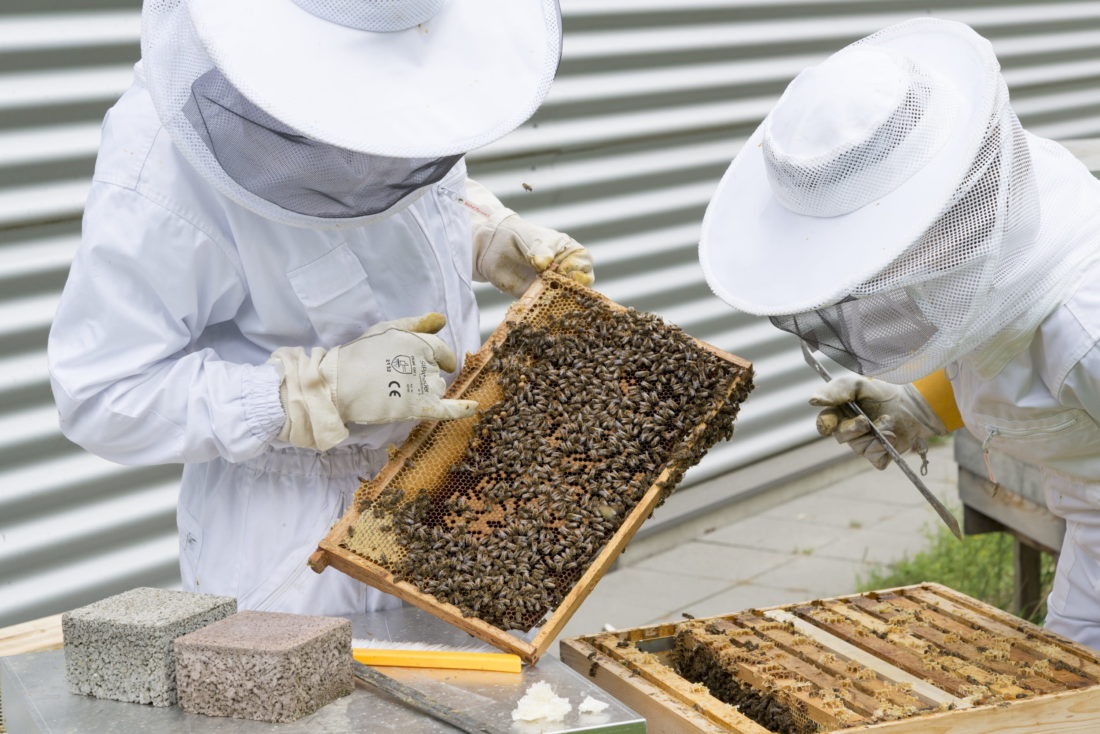
Another practice to allow beekeepers to take the honey, or inspect the bees is called ‘smoking out’. Smoke is released to subdue and confuse the bees, as smoke interferes with their sense of smell and ability to be controlled by the pheromones in the ‘queen signal’, which means that the bees are less likely to defend themselves.8Fisher, L. 2020. How does smoke subdue bees? Available at: https://www.sciencefocus.com/nature/how-does-smoke-subdue-bees/#:~:text=Beekeepers%20often%20use%20a%20’smoker,primary%20form%20of%20communication%3A%20smell.&text=When%20honey%20bees%20become%20alarmed,isopentyl%20acetate%20and%202%2Dheptanone.
Sugar water
In commercial farming, the honey that the bees have worked so hard to produce, and save for winter, is extracted for human consumption. Without food they would starve, so farmers replace their honey with a sugar-water solution. This solution lacks the essential nutrients found in their honey.
Without the antioxidants found in honey, bees are left in a poor nutritional state and more susceptible to disease. Mass die-offs of hives in the UK over recent decades, has been in part blamed on this. In the winter of 2012 to 2013, one-third of all honey bee colonies in the UK were wiped out due to a particularly cold winter and disease.9Benjamin, A. 2013. Third of all honeybee colonies in England did not survive winter. Available at: https://www.theguardian.com/environment/2013/jun/13/honeybee-colonies-england-winter
Instead of keeping the bees alive, some will farmers will ‘cull’ their hive before winter to save money.10Carlin, A. 2016. Why don’t vegans eat honey? You asked Google – here’s the answer. Available at: https://www.theguardian.com/commentisfree/2016/oct/19/why-dont-vegans-eat-honey-google-questions
Methods used for the culling include: burning the hive alive, drowning the bees by pouring soapy water over the hive, or gassing them to death with carbon dioxide. Beekeepers will also sometimes capture bees in a plastic bag and leave them in the sun to die of overheating and suffocation.
Disease
Disease can quickly spread in hives, and this is exacerbated when the bees are nutritionally deficient or stressed. Diseases can also be spread by importing different species of bees into hives to increase productivity. These diseases can then spread to other pollinators, having a much wider impact on the environment and biodiversity.
The parasitic mite – varoa – is the number one threat to intensively farmed bee colonies in the UK. It is a crab-like mite that feasts on the blood of bees and can collapse colonies in a very short space of time. It spread to the UK in the 1950s from the Asian honey bee.11Martin, S. 2010. The honeybee and the varroa mite. Available at: http://news.bbc.co.uk/local/sheffield/hi/people_and_places/newsid_8886000/8886387.stm
AFB (American Foul Brood) and EFB (European Foul Brood) are other diseases which affect the larvae in the hive. Spores of AFB can remain dormant on beekeeping equipment for up to 50 years, so this is normally destroyed by the farmer burning the hive, and all the bees in it, alive.12Bbka.org.uk.2020. What diseases & pests do honeybees suffer from? Available at: https://www.bbka.org.uk/what-diseases-pests-do-honeybees-suffer-from
Bees and the environment
Bees are essential for flower and crop pollination and to maintain local and global biodiversity. They pollinate 70 of the around 100 crop species that feed 90 per cent of the world’s population.13Bbc.com. 2020. What would happen if bees went extinct? Available at: https://www.bbc.com/future/article/20140502-what-if-bees-went-extinct
All bees pollinate by accidentally transferring pollen from one flower to another whilst they are collecting nectar. Pollen from the male part of one flower is transferred to the female part of another, and that is how they are fertilised to produce seeds or fruit. This ancient system maintains delicate ecosystems and ensures thriving biodiversity.
Sadly, many wild bee species have been in decline in recent decades. The loss of wildflower meadows to make way for industrial farming is a big factor in habitat loss.14Orde, E. 2019. Eating honey is bad for bees. Available at:https://theecologist.org/2019/aug/21/eating-honey-bad-bees The loss of natural habitats due to climate change, and overuse of harmful pesticides are also cited as a reason for mass die-offs of bees.15Gross, L. 2019. Pesticides Are Harming Bees in Literally Every Possible Way. Available at: https://www.wired.com/story/pesticides-are-harming-bees-in-literally-every-possible-way/
Scientists are increasingly worried about ‘colony collapse disorder’, a phenomenon affecting honey bees globally, where European honey bees are leaving their colonies never to return. In some parts of the world 90 per cent of bees have disappeared.16Holland, J. 2013. The Plight of the Honeybee. Available at: https://www.nationalgeographic.com/news/2013/5/130510-honeybee-bee-science-european-union-pesticides-colony-collapse-epa-science/ Whilst it is still a mystery exactly why this is happening, one of the primary suggested causes is contamination of the bees food stores due to the amount, and toxicity, of pesticides now used on crops.17Hood, M. 2018. Colony collapse disorder. Encyclopædia Britannica, inc. Available at: https://www.britannica.com/science/colony-collapse-disorder [Accessed 16th June 2020]
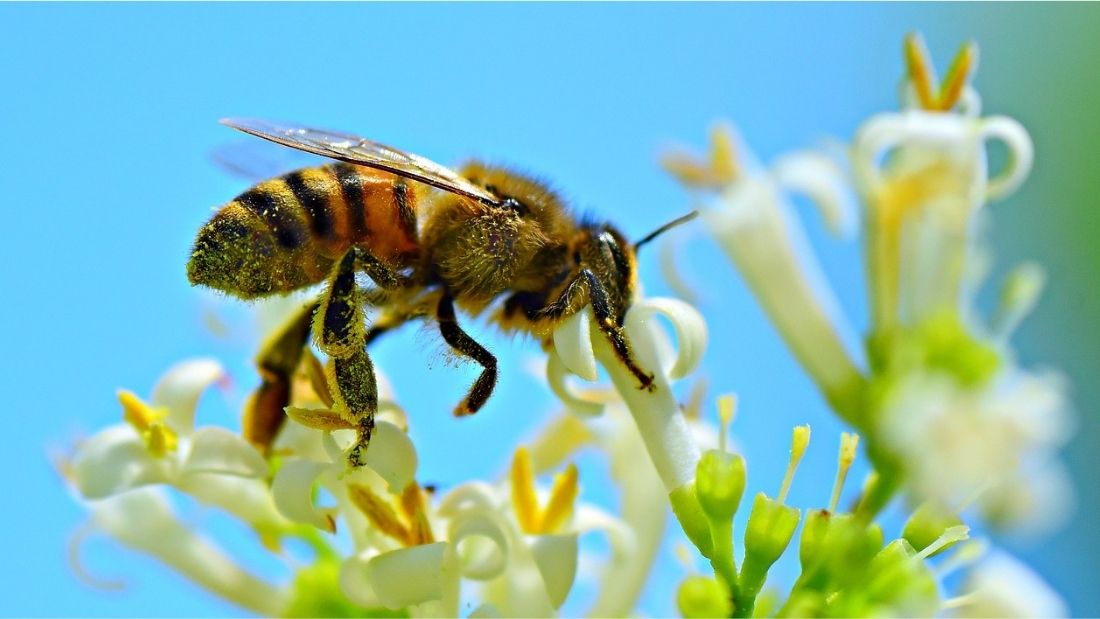
Does farming honey bees help the environment?
While they are effective pollinators, responsible for around half of all commercial crop pollination worldwide, too many honeybees can actively harm the native wild bee population.18Harris-Lovett, S. 2015. Rising temperatures due to climate change are latest threat to bumblebees. Available at: https://www.latimes.com/science/sciencenow/la-sci-sn-bumble-bees-climate-change-habitat-loss-20150709-story.html They compete directly for the same nectar and pollen, and with wildflower meadows in rapid decline, initiatives promoting beekeeping can actually contribute to wild bee decline.19Norfolk, O. 2018. Keeping honeybees doesn’t save bees – or the environment. Available at: https://theconversation.com/keeping-honeybees-doesnt-save-bees-or-the-environment-102931 It is important to local ecosystems that there are a variety of pollinators as different pollinators pollinate different plants, and provide habitats for different species.
Among wild bees the majority of pollinating of commercial crops is carried out by just two per cent of known species, making their existence incredibly fragile. Other wild bee species are no less important to biodiversity, as they pollinate wild plants that provide food for local wildlife.18Harris-Lovett, S. 2015. Rising temperatures due to climate change are latest threat to bumblebees. Available at: https://www.latimes.com/science/sciencenow/la-sci-sn-bumble-bees-climate-change-habitat-loss-20150709-story.html
Honey bee colonies are traded locally and internationally which allows the spread of disease to wild bee populations. In the US, honey bees are shipped around to pollinate specific crops such as almonds. This negatively contributes to the spread of disease and the wiping out of native bee populations.14Orde, E. 2019. Eating honey is bad for bees. Available at:https://theecologist.org/2019/aug/21/eating-honey-bad-bees It is also bad news for the honey bees who fail to thrive in these alien environments. Using honey bee colonies in this way contributes to their loss in the billions. More than one-third of US bees were wiped out in the winter 2018-19, and more bees die every year in the US alone than all slaughtered fish and land animals combined.20McGiveny, A. 2020. ‘Like sending bees to war’: the deadly truth behind your almond milk obsession. Available at: https://www.theguardian.com/environment/2020/jan/07/honeybees-deaths-almonds-hives-aoe
Honey bees build finely balanced and highly cooperative communities. They are an endless source of fascination to scientists who are constantly finding out more about the way that they operate and communicate with one another. The extraordinary hard work that honey bees put into producing enough honey for their hive makes it all the more devastating that humans feel that it is their right to take it for themselves. The only way to stop this exploitation of bees, and other animals, for food, is to go vegan.






